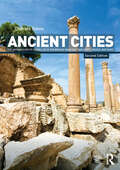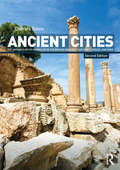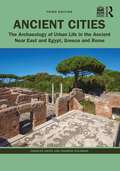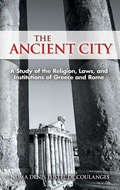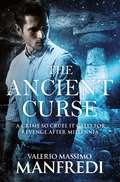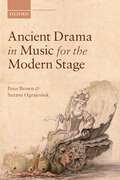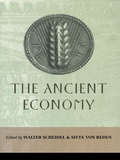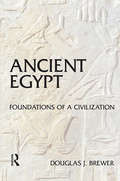- Table View
- List View
Ancient Cities: The Archaeology of Urban Life in the Ancient Near East and Egypt, Greece and Rome
by Charles GatesAncient Cities surveys the cities of the Ancient Near East, Egypt, and the Greek and Roman worlds from the perspectives of archaeology and architectural history, bringing to life the physical world of ancient city dwellers by concentrating on evidence recovered from archaeological excavations. Urban form is the focus: the physical appearance and overall plans of the cities, their architecture and natural topography, and the cultural and historical contexts in which they flourished. Attention is also paid to non-urban features such as religious sanctuaries and burial grounds, places and institutions that were a familiar part of the city dweller's experience. Objects or artifacts that represented the essential furnishings of everyday life are discussed, such as pottery, sculpture, wall paintings, mosaics and coins. Ancient Cities is unusual in presenting this wide range of Old World cultures in such comprehensive detail, giving equal weight to the Preclassical and Classical periods, and in showing the links between these ancient cultures. User-friendly features include: use of clear and accessible language, assuming no previous background knowledge lavishly illustrated with over 300 line drawings, maps, and photos historical summaries, further reading arranged by topic, plus a consolidated bibliography and comprehensive index new to the second edition: a companion website with an interactive timeline, chapter summaries, study questions, illustrations and a glossary of archaeological and historical terms. Visit the website at http://cw.routledge.com/textbooks/9780415498647/ In this second edition, Charles Gates has comprehensively revised and updated his original text, and Neslihan Y?lmaz has reworked her acclaimed illustrations. Readers and lecturers will be delighted to see a new chapter on Phoenician cities in the first millennium BC, and new sections on Göbekli Tepe, the sensational Neolithic sanctuary; Sinope, a Greek city on the Black Sea coast; and cities of the western Roman Empire. With its comprehensive presentation of ancient Mediterranean and Near Eastern cities, its rich collection of illustrations, and its new companion website, Ancient Cities will remain an essential textbook for university and high school students across a wide range of archaeology, ancient history, and ancient Near Eastern, Biblical, and classical studies courses.
Ancient Cities: The Archaeology of Urban Life in the Ancient Near East and Egypt, Greece and Rome
by Charles GatesAncient Cities surveys the cities of the Ancient Near East, Egypt, and the Greek and Roman worlds from the perspectives of archaeology and architectural history, bringing to life the physical world of ancient city dwellers by concentrating on evidence recovered from archaeological excavations. Urban form is the focus: the physical appearance and overall plans of the cities, their architecture and natural topography, and the cultural and historical contexts in which they flourished. Attention is also paid to non-urban features such as religious sanctuaries and burial grounds, places and institutions that were a familiar part of the city dweller's experience. Objects or artifacts that represented the essential furnishings of everyday life are discussed, such as pottery, sculpture, wall paintings, mosaics and coins. Ancient Cities is unusual in presenting this wide range of Old World cultures in such comprehensive detail, giving equal weight to the Preclassical and Classical periods, and in showing the links between these ancient cultures. User-friendly features include: use of clear and accessible language, assuming no previous background knowledge lavishly illustrated with over 300 line drawings, maps, and photos historical summaries, further reading arranged by topic, plus a consolidated bibliography and comprehensive index new to the second edition: a companion website with an interactive timeline, chapter summaries, study questions, illustrations and a glossary of archaeological and historical terms. Visit the website at http://cw.routledge.com/textbooks/9780415498647/ In this second edition, Charles Gates has comprehensively revised and updated his original text, and Neslihan Y?lmaz has reworked her acclaimed illustrations. Readers and lecturers will be delighted to see a new chapter on Phoenician cities in the first millennium BC, and new sections on Göbekli Tepe, the sensational Neolithic sanctuary; Sinope, a Greek city on the Black Sea coast; and cities of the western Roman Empire. With its comprehensive presentation of ancient Mediterranean and Near Eastern cities, its rich collection of illustrations, and its new companion website, Ancient Cities will remain an essential textbook for university and high school students across a wide range of archaeology, ancient history, and ancient Near Eastern, Biblical, and classical studies courses.
Ancient Cities: The Archaeology of Urban Life in the Ancient Near East and Egypt, Greece, and Rome
by Charles Gates Andrew GoldmanThe third edition of Ancient Cities surveys the cities of the Ancient Near East, Egypt, and the Greek, Etruscan, and Roman worlds from the perspectives of archaeology and architectural history, bringing to life the physical world of ancient city dwellers by concentrating on archaeological evidence.Urban form is the focus: the physical appearance and overall plans of cities, their architecture and natural topography, and the cultural and historical contexts in which they flourished. Attention is also paid to non-urban features such as religious sanctuaries and burial grounds, places and institutions that were a familiar part of the city dweller’s experience. Objects or artifacts that furnished everyday life are discussed, such as writing systems, pottery, sculpture, wall paintings, mosaics, and coins. Ancient Cities is unusual in presenting this wide range of Old World cultures in such comprehensive detail, giving equal weight to the Preclassical and Classical periods, and in showing the links between these ancient cultures. In this new edition, in which Andrew Goldman has joined Charles Gates in updating the volume, readers and lecturers will be delighted to see a major revision of the chapters on Greek cities in South Italy and Sicily, the Etruscans, the development of the capital city, Rome, during the Republic as well as the Empire, and the end of the ancient city.This new edition includes several new and updated user-friendly features, such as: Clear and accessible language, assuming no previous background knowledge Lavishly illustrated, with almost 350 line drawings, maps, and photographs, including new contributions from Neslihan Yılmaz Tekman adding to her already acclaimed illustrations Suggestions for further reading for each chapter A companion website with images, study guides, and an interactive timeline. With its comprehensive presentation of ancient Mediterranean and Near Eastern cities, its rich collection of illustrations, and its companion website, Ancient Cities remains an essential textbook for university and high school students across a wide range of archaeology, ancient history, and ancient Near Eastern, Biblical, and Classical Studies courses.
Ancient Cities: The Archaeology of Urban Life in the Ancient Near East and Egypt, Greece, and Rome
by Charles Gates Andrew GoldmanThe third edition of Ancient Cities surveys the cities of the Ancient Near East, Egypt, and the Greek, Etruscan, and Roman worlds from the perspectives of archaeology and architectural history, bringing to life the physical world of ancient city dwellers by concentrating on archaeological evidence.Urban form is the focus: the physical appearance and overall plans of cities, their architecture and natural topography, and the cultural and historical contexts in which they flourished. Attention is also paid to non-urban features such as religious sanctuaries and burial grounds, places and institutions that were a familiar part of the city dweller’s experience. Objects or artifacts that furnished everyday life are discussed, such as writing systems, pottery, sculpture, wall paintings, mosaics, and coins. Ancient Cities is unusual in presenting this wide range of Old World cultures in such comprehensive detail, giving equal weight to the Preclassical and Classical periods, and in showing the links between these ancient cultures. In this new edition, in which Andrew Goldman has joined Charles Gates in updating the volume, readers and lecturers will be delighted to see a major revision of the chapters on Greek cities in South Italy and Sicily, the Etruscans, the development of the capital city, Rome, during the Republic as well as the Empire, and the end of the ancient city.This new edition includes several new and updated user-friendly features, such as: Clear and accessible language, assuming no previous background knowledge Lavishly illustrated, with almost 350 line drawings, maps, and photographs, including new contributions from Neslihan Yılmaz Tekman adding to her already acclaimed illustrations Suggestions for further reading for each chapter A companion website with images, study guides, and an interactive timeline. With its comprehensive presentation of ancient Mediterranean and Near Eastern cities, its rich collection of illustrations, and its companion website, Ancient Cities remains an essential textbook for university and high school students across a wide range of archaeology, ancient history, and ancient Near Eastern, Biblical, and Classical Studies courses.
The Ancient City: A Study of the Religion, Laws, and Institutions of Greece and Rome
by Numa Denis Fustel de Coulanges Willard SmallWith this influential study, French historian Numa Denis Fustel de Coulanges initiated a new approach to Greek and Roman city organization. Fustel de Coulanges' 1864 masterpiece, La Cité antique, drew upon physical evidence as well as ancient documents rather than the usual post-Classical histories. The result is a fresh, accurate, and detailed portrait of the religious, family, and civic life of Periclean Athens and Rome during the time of Cicero.This fascinating sociological account reveals the significance of kinship and the cult of the family hearth and ancestors to ancient Hellenic and Latin urban culture. It chronicles the rise of family-centered pagan belief systems, tracing their gradual decline to the spread of Christianity. Fustel cites ancient Indian and Hebrew texts as well as Greek and Roman sources. The ingenuity of his interpretations, along with his striking prose style, offer readers a vital and enduring historic survey.
The Ancient City of Athens: Its Topography and Monuments (Routledge Library Editions: The Ancient World)
by Ida Thallon HillThe Ancient City of Athens (1953) contains both definite reports of the actual discoveries in the excavations which revolutionised previous topographical views of Athens, and articles and discussions to which these new discoveries gave rise. It is a comprehensive examination of the main topography and major monuments of the ancient city.
The Ancient City of Athens: Its Topography and Monuments (Routledge Library Editions: The Ancient World)
by Ida Thallon HillThe Ancient City of Athens (1953) contains both definite reports of the actual discoveries in the excavations which revolutionised previous topographical views of Athens, and articles and discussions to which these new discoveries gave rise. It is a comprehensive examination of the main topography and major monuments of the ancient city.
The Ancient Commentators on Plato and Aristotle
by Miira TuominenIn late antiquity the works of Plato and Aristotle were subject to intense study, which eventually led to the development of a new literary form, the philosophical commentary. Until recently these commentaries were understood chiefly as sources of information for the masters - Plato and Aristotle - they commented upon. However, in recent years, it has become increasingly acknowledged that the commentators themselves - Aspasius, Alexander, Themistius, Porphyry, Proclus, Philoponus, Simplicius and others - even though they worked in the Platonist - Aristotelian framework, contributed to this tradition in original, innovative and significant ways such that their commentaries are philosophically important sources in their own right. This book provides the first systematic introduction to the 'philosophy' of the commentators: their way of doing philosophy and the kind of philosophical problems they found interesting.Although there was no philosophy of the commentators in the sense of a definite set of doctrines, Tuominen shows how the commentary format was nevertheless a vehicle for original philosophical theorizing and argues convincingly that the commentators should take their place alongside other philosophers of antiquity in the history of western philosophy.
The Ancient Commentators on Plato and Aristotle (Ancient Philosophies Ser. #6)
by Miira TuominenIn late antiquity the works of Plato and Aristotle were subject to intense study, which eventually led to the development of a new literary form, the philosophical commentary. Until recently these commentaries were understood chiefly as sources of information for the masters - Plato and Aristotle - they commented upon. However, in recent years, it has become increasingly acknowledged that the commentators themselves - Aspasius, Alexander, Themistius, Porphyry, Proclus, Philoponus, Simplicius and others - even though they worked in the Platonist - Aristotelian framework, contributed to this tradition in original, innovative and significant ways such that their commentaries are philosophically important sources in their own right. This book provides the first systematic introduction to the 'philosophy' of the commentators: their way of doing philosophy and the kind of philosophical problems they found interesting.Although there was no philosophy of the commentators in the sense of a definite set of doctrines, Tuominen shows how the commentary format was nevertheless a vehicle for original philosophical theorizing and argues convincingly that the commentators should take their place alongside other philosophers of antiquity in the history of western philosophy.
Ancient Cosmologies (Routledge Library Editions: The Ancient World)
by Michael Loewe Carmen BlackerIn Ancient Cosmologies (1975) nine eminent scholars seek to answer the question, what was the shape of the universe imagined by those ancient peoples to whom all modern knowledge of geography and astronomy was inaccessible? How did the ancient Egyptians, Babylonians, Jews, Indians, Chinese, Arabs, Greeks and Norsemen conceive the form of the cosmos which accommodated not only the known face of the earth and the visible heavenly bodies but also those other worlds which it was deemed necessary to locate comprehensibly in space – the realms of the dead, both blessed and damned, and the countries inhabited by gods and demons?
Ancient Cosmologies (Routledge Library Editions: The Ancient World)
In Ancient Cosmologies (1975) nine eminent scholars seek to answer the question, what was the shape of the universe imagined by those ancient peoples to whom all modern knowledge of geography and astronomy was inaccessible? How did the ancient Egyptians, Babylonians, Jews, Indians, Chinese, Arabs, Greeks and Norsemen conceive the form of the cosmos which accommodated not only the known face of the earth and the visible heavenly bodies but also those other worlds which it was deemed necessary to locate comprehensibly in space – the realms of the dead, both blessed and damned, and the countries inhabited by gods and demons?
Ancient Crosses of The Three Choirs Counties
by Marion FreemanCrosses are a quintessential part of the English countryside. Whether standing proud in the village market place or hidden beneath ivy in a forgotten corner of the churchyard, each has its own story to tell. Many of these crosses have ancient origins, dating back to a time when wandering preachers were making the push to convert a wary pagan population, whilst others are far more modern, often serving as memorials to the dead of the two world wars. Many were disfigured by the fervent Puritanism of the Commonwealth period, whilst others have been rebuilt and redesigned to such an extent that they no longer resemble a traditional cross at all. The countryside cross is also more than just a religious symbol; many act as signposts, boundary markers or meeting places. Gloucestershire, Herefordshire and Worcestershire, often known as the 'Three Choirs Counties', are blessed with a plethora of these crosses. Here, Marion Freeman provides the reader with a wealth of information, drawn from years of in-depth research and visits to all of the sites listed. Also included is a gazetteer section explaining the location and brief history of the crosses in each region; a map reference is given to help the reader seek out these intriguing monuments for themselves.
The Ancient Curse
by Valerio Massimo ManfrediValerio Massimo Manfredi's The Ancient Curse is a thrilling archaeological mystery with a supernatural twist.In the darkest hours of the night at the Museum of Volterra, young archaeologist Fabrizio Castellani is immersed in his work. He has discovered that the famous Etruscan statue known as the 'shade of twilight' contains a mysterious object, seemingly enclosed within the sculpture itself. He is suddenly interrupted by the phone ringing – on the other end of the line an icy female voice warns him to abandon his research at once. A series of gruesome killings follow. The victims, who have all been involved in the desecration of an unexplored tomb, seem to have been torn to pieces by a beast of unimaginable size. Meanwhile, as Fabrizio excavates the Etruscan tomb he discovers something extraordinary, and chilling . . . Will Fabrizio manage to unravel these secrets without being sucked into the spiral of violence himself?
Ancient Divination and Experience
by Esther Eidinow Lindsay G. Driediger-MurphyThis volume sets out to re-examine what ancient people - primarily those in ancient Greek and Roman communities, but also Mesopotamian and Chinese cultures - thought they were doing through divination, and what this can tell us about the religions and cultures in which divination was practised. The chapters, authored by a range of established experts and upcoming early-career scholars, engage with four shared questions: What kinds of gods do ancient forms of divination presuppose? What beliefs, anxieties, and hopes did divination seek to address? What were the limits of human 'control' of divination? What kinds of human-divine relationships did divination create/sustain? The volume as a whole seeks to move beyond functionalist approaches to divination in order to identify and elucidate previously understudied aspects of ancient divinatory experience and practice. Special attention is paid to the experiences of non-elites, the perception of divine presence, the ways in which divinatory techniques could surprise their users by yielding unexpected or unwanted results, the difficulties of interpretation with which divinatory experts were thought to contend, and the possibility that divination could not just ease, but also exacerbate, anxiety in practitioners and consultants.
Ancient Divination and Experience
This volume sets out to re-examine what ancient people - primarily those in ancient Greek and Roman communities, but also Mesopotamian and Chinese cultures - thought they were doing through divination, and what this can tell us about the religions and cultures in which divination was practised. The chapters, authored by a range of established experts and upcoming early-career scholars, engage with four shared questions: What kinds of gods do ancient forms of divination presuppose? What beliefs, anxieties, and hopes did divination seek to address? What were the limits of human 'control' of divination? What kinds of human-divine relationships did divination create/sustain? The volume as a whole seeks to move beyond functionalist approaches to divination in order to identify and elucidate previously understudied aspects of ancient divinatory experience and practice. Special attention is paid to the experiences of non-elites, the perception of divine presence, the ways in which divinatory techniques could surprise their users by yielding unexpected or unwanted results, the difficulties of interpretation with which divinatory experts were thought to contend, and the possibility that divination could not just ease, but also exacerbate, anxiety in practitioners and consultants.
Ancient DNA: The Making of a Celebrity Science
by Elizabeth D JonesThe untold story of the rise of the new scientific field of ancient DNA research, and how Jurassic Park and popular media influenced its development Ancient DNA research—the recovery of genetic material from long-dead organisms—is a discipline that developed from science fiction into a reality between the 1980s and today. Drawing on scientific, historical, and archival material, as well as original interviews with more than fifty researchers worldwide, Elizabeth Jones explores the field’s formation and explains its relationship with the media by examining its close connection to de-extinction, the science and technology of resurrecting extinct species. She reveals how the search for DNA from fossils flourished under the influence of intense press and public interest, particularly as this new line of research coincided with the book and movie Jurassic Park. Ancient DNA is the first account to trace the historical and sociological interplay between science and celebrity in the rise of this new research field. In the process, Jones argues that ancient DNA research is more than a public-facing science: it is a celebrity science.
Ancient Drama in Music for the Modern Stage
by Peter BrownOpera was invented at the end of the sixteenth century in imitation of the supposed style of delivery of ancient Greek tragedy, and, since then, operas based on Greek drama have been among the most important in the repertoire. This collection of essays by leading authorities in the fields of Classics, Musicology, Dance Studies, English Literature, Modern Languages, and Theatre Studies provides an exceptionally wide-ranging and detailed overview of the relationship between the two genres. Since tragedies have played a much larger part than comedies in this branch of operatic history, the volume mostly concentrates on the tragic repertoire, but a chapter on musical versions of Aristophanes' Lysistrata is included, as well as discussions of incidental music, a very important part of the musical reception of ancient drama, from Andrea Gabrieli in 1585 to Harrison Birtwistle and Judith Weir in the late twentieth and early twenty-first centuries.
An Ancient Dream Manual: Artemidorus' The Interpretation of Dreams
by Peter ThonemannArtemidorus' Oneirocritica ('The Interpretation of Dreams') is the only dream-book which has been preserved from Graeco-Roman antiquity. Composed around AD 200, it comprises a treatise and manual on dreams, their classification, and the various analytical tools which should be applied to their interpretation, making Artemidorus both one of the earliest documented and arguably the single most important predecessor and precursor of Freud. Artemidorus travelled widely through Greece, Asia, and Italy to collect people's dreams and record their outcomes, in the process casting a vivid light on social mores and religious beliefs in the Severan age: this volume, published as a companion to the new translation of The Interpretation of Dreams by Martin Hammond in the Oxford World's Classics series, aims to provide the non-specialist reader with a readable and engaging road-map to this vast and complex text. It offers a detailed analysis of Artemidorus' theory of dreams and the social function of ancient dream-interpretation, while also aiming to foster an understanding of the ways in which Artemidorus might be of interest to the cultural or social historian of the Graeco-Roman world. Alongside chapters on Artemidorus' life, career, and world-view, it also provides valuable insights into his conceptions of the human body, sexuality, the natural world, and the gods; his attitudes towards Rome, the contemporary Greek polis, and the social order; and his knowledge of Greek literature, myth, and history. In addition, its accessible exploration of the differences and similarities between ancient traditions of dream-analysis and modern psychoanalytic approaches will make this volume of interest to anybody with an interest in the history of dreams and dream interpretation.
An Ancient Dream Manual: Artemidorus' The Interpretation of Dreams
by Peter ThonemannArtemidorus' Oneirocritica ('The Interpretation of Dreams') is the only dream-book which has been preserved from Graeco-Roman antiquity. Composed around AD 200, it comprises a treatise and manual on dreams, their classification, and the various analytical tools which should be applied to their interpretation, making Artemidorus both one of the earliest documented and arguably the single most important predecessor and precursor of Freud. Artemidorus travelled widely through Greece, Asia, and Italy to collect people's dreams and record their outcomes, in the process casting a vivid light on social mores and religious beliefs in the Severan age: this volume, published as a companion to the new translation of The Interpretation of Dreams by Martin Hammond in the Oxford World's Classics series, aims to provide the non-specialist reader with a readable and engaging road-map to this vast and complex text. It offers a detailed analysis of Artemidorus' theory of dreams and the social function of ancient dream-interpretation, while also aiming to foster an understanding of the ways in which Artemidorus might be of interest to the cultural or social historian of the Graeco-Roman world. Alongside chapters on Artemidorus' life, career, and world-view, it also provides valuable insights into his conceptions of the human body, sexuality, the natural world, and the gods; his attitudes towards Rome, the contemporary Greek polis, and the social order; and his knowledge of Greek literature, myth, and history. In addition, its accessible exploration of the differences and similarities between ancient traditions of dream-analysis and modern psychoanalytic approaches will make this volume of interest to anybody with an interest in the history of dreams and dream interpretation.
Ancient Economies in Comparative Perspective: Material Life, Institutions and Economic Thought (Frontiers in Economic History)
by Marcella Frangipane Monika Poettinger Bertram SchefoldThis book investigates the economic organization of ancient societies from a comparative perspective. By pursuing an interdisciplinary approach, including contributions by archaeologists, historians of antiquity, economic historians as well as historians of economic thought, it studies various aspects of ancient economies, such as the material living conditions including production technologies, etc.; economic institutions such as markets and coinage; as well as the economic thinking of the time. In the process, it also explores the comparability of economic thought, economic institutions and economic systems in ancient history. Focusing on the Ancient Near East as well as the Mediterranean, including Greece and Rome, this comparative perspective makes it possible to identify historical permanencies, but also diverse forms of social and political organization and cultural systems. These institutions are then evaluated in terms of their capacity to solve economic problems, such as the efficient use of resources or political stability. The first part of the book introduces readers to the methodological context of the comparative approach, including an evaluation of the related historiographical tradition. Subsequent parts discuss a range of development models, elements of economic thinking in ancient societies, the role of trade and globalization, and the use of monetary and financial instruments, as well as political aspects.
The Ancient Economy (Edinburgh Readings On The Ancient World Ser.)
by Walter Scheidel Sitta von RedenThe Ancient Economy introduces readers to the nature of economic life in the ancient world, and provides a valuable guide to scholarly debates on the subject. The book describes and examines the economic processes and fluctuations of the ancient world, and shows how these relate to political and social change and conditions. Leading experts address the central issues, from agricultural production to the uses of money and the creation of markets. Taken as a whole the book exemplifies the range of interdisciplinary perspectives on the ancient economy, and illustrates the methodological approaches scholars have deployed to understand it. In doing so it draws on literary, ecological and archaeological evidence.
The Ancient Economy
by Walter Scheidel Sitta von RedenThe Ancient Economy introduces readers to the nature of economic life in the ancient world, and provides a valuable guide to scholarly debates on the subject. The book describes and examines the economic processes and fluctuations of the ancient world, and shows how these relate to political and social change and conditions. Leading experts address the central issues, from agricultural production to the uses of money and the creation of markets. Taken as a whole the book exemplifies the range of interdisciplinary perspectives on the ancient economy, and illustrates the methodological approaches scholars have deployed to understand it. In doing so it draws on literary, ecological and archaeological evidence.
Ancient Education and Early Christianity (The Library of New Testament Studies #533)
by Matthew Ryan Hauge Andrew W. PittsWhat was the relationship of ancient education to early Christianity? This volume provides an in-depth look at different approaches currently employed by scholars who draw upon educational settings in the ancient world to inform their historical research in Christian origins. The book is divided into two sections: one consisting of essays on education in the ancient world, and one consisting of exegetical studies dealing with various passages where motifs emerging from ancient educational culture provide illumination. The chapters summarize the state of the discussion on ancient education in classical and biblical studies, examine obstacles to arriving at a comprehensive theory of early Christianity's relationship to ancient education, compare different approaches, and compile the diverse methodologies into one comparative study. Several educational motifs are integrated in order to demonstrate the exegetical insights that they may yield when utilized in New Testament historical investigation and interpretation.
Ancient Egypt: Foundations of a Civilization
by Douglas J. BrewerAncient Egypt is a beautifully illustrated, easy-to-read book covering the formative era of the Egyptian civilization: the age before the pyramids. Douglas Brewer shows why an awareness of the earliest phase of Egyptian history is crucial to understanding of later Egyptian culture. Beginning with a quick review of the fields of Egyptology and archaeology, Ancient Egypt takes the reader on a compelling survey of Egypt's prehistoric past. The books tours the Nile Valley to explore its impact on all aspects of life, from day-to-day living to regional politics, and introduces the reader to the Nile Valley's earliest inhabitants and the very first "Egyptians".
Ancient Egypt: Foundations of a Civilization
by Douglas J. BrewerAncient Egypt is a beautifully illustrated, easy-to-read book covering the formative era of the Egyptian civilization: the age before the pyramids. Douglas Brewer shows why an awareness of the earliest phase of Egyptian history is crucial to understanding of later Egyptian culture. Beginning with a quick review of the fields of Egyptology and archaeology, Ancient Egypt takes the reader on a compelling survey of Egypt's prehistoric past. The books tours the Nile Valley to explore its impact on all aspects of life, from day-to-day living to regional politics, and introduces the reader to the Nile Valley's earliest inhabitants and the very first "Egyptians".
